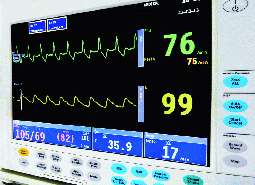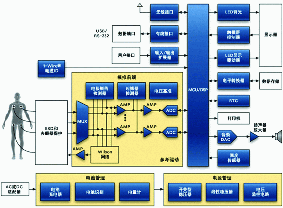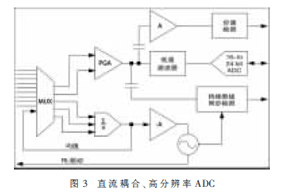Electrocardiogram (ECG or EKG) is used to measure the myocardial electrical signal that changes with time, and the measurement results are graphically displayed. The application range of ECG ranges from simple heart rate monitoring to special heart condition diagnosis. In any application, ECG's testing principles are the same, but the design details and requirements for electronic components vary greatly, from portable devices that cost less than $ 200 to desktop devices that are more than $ 5,000 and are the same size as a fax machine. In some applications, ECG is even embedded in other instruments, such as patient monitors, automatic external defibrillators (AED), etc., as shown in Figure 1.

Figure 1 ECG and blood oxygen readings displayed on the patient monitor
All ECGs collect ECG signals through electrodes connected to specific parts of the body. The amplitude of the ECG signals generated by the body is only a few millivolts. Through the electrodes connected to specific positions of the body, ECG activities can be observed from different angles The position can be displayed and printed as an output channel of ECG. Each channel represents the differential voltage between two electrodes or the difference between the average voltage of a certain electrode and several electrodes. Different combinations between electrodes can show the number of specific electrodes. More channels. These channels are generally called "leads" (or "channels"), and a 12-lead ECG device has 12 independent graphical display channels. Based on different applications, the number of leads can be selected from 1 to 12. The problem is that the wire connecting the electrodes is sometimes called a lead, which is confusing, because the 12-lead (12-channel) ECG only requires 10 electrodes (10 wires), so carefully judge the "lead United ".
In addition to biological signals, most ECGs will also detect two artificial signals, of which the implantable cardiac pacemaker (referred to as the "pacing" signal for short) is the most important signal. The pacing signal time is quite short, from tens of microseconds to a few milliseconds, and the amplitude is from a few millivolts to nearly 1 V. Generally, ECG must also detect the presence of pacing signals to prevent interference with other ECG signals. The second type of artificial signal is used to detect "lead drop", that is, poor contact of the electrode. Many ECGs need to issue an alarm indication when the electrode is in poor contact. To this end, the ECG device generates a signal for measuring the impedance between the electrode and the human body, thereby detecting whether there is lead loss. The measurement signal can be AC ​​or DC, or both. Some ECGs can also detect the respiratory rate by analyzing impedance when detecting the state of lead detachment. The lead-off state should be continuously detected, and it cannot prevent accurate measurement of the ECG signal.
Figure 2 shows the overall functional block diagram of ECG. If the ECG is divided into an analog front end (AFE) that digitally converts the signal and the "rest" that will analyze, display, store, and transmit data, it is easier to understand the requirements of the electrocardiograph for electronic components. AFE usually has the same basic requirements, the difference is the number of leads, signal fidelity, interference suppression capabilities, etc. Depending on the specific functional requirements, the "rest" of the system varies greatly. Typical functions include displays, printing hardware copies, wireless (RF) connections, and battery charging.

Figure 2 ECG overall functional block diagram
Lead number (derivative)
One of the most significant features is the number of leads. Some ECGs have only one lead, while others have up to 12 leads. The most commonly used 12-lead ECG requires 10 electrodes, 9 of which are used to collect electrical signals. The 10th electrode is connected to the right leg (RL) and driven by the ECG circuit to reduce the common-mode voltage. The nine input electrodes are one electrode for each of the left arm (LA), right arm (RA), and left leg (LL), and six electrodes (V1-V6) in the anterior heart (chest) area. Each lead or cardiogram shows the voltage difference between one electrode and another electrode or a group of electrodes. If the electrodes are grouped, the average voltage is taken. The 6 leads led out by the three electrodes of RA, LA and LL are averaged and used as one side of the differential pair, and V1 to V6 are used as the other side of the 6 differential pairs. There are 3 leads from RA, LA, LL and the difference between the average of the other two electrodes. The remaining three leads are the results of measuring RA, LA, and LL as independent differential pairs. The six leads based on RA, LA, and LL contain similar information, but are displayed in different ways. Because the information is redundant, there is no need to measure all 6 leads. Some channel data can be analyzed and calculated by DSP on other channel data.
What is described here is the most commonly used 12-lead system, but it is not the only solution. In addition, the 12-lead ECG can also be used as a 5-lead, 3-lead, or 1-lead system. The key is that when more than one lead is needed, a switch array and averaging circuit are required.
Analog Front End (AFE)
The main function of AFE is to digitize the ECG signal. Due to the need to suppress strong interference such as RF signal source, pacing signal, lead shedding detection signal, power frequency common mode signal and other body signals and electronic noise, the processing process is very complicated . In addition, millivolt-level ECG signals may be superimposed on a DC offset voltage of hundreds of millivolts, and the common-mode voltage between channels may exceed 1 V. The electrodes connected to the patient's body must not create a shock hazard or interfere with other medical devices connected to the patient. The effective frequency range of ECG is somewhat related to the application, and is usually between 0.05 Hz and 100 Hz.
The second function of AFE is to be able to detect pacing signals, lead shedding, respiratory rate and patient impedance. The detection works on several channels simultaneously or almost simultaneously. In addition, when defibrillating, most ECG devices need to recover quickly, but because the defibrillation causes saturation of the front-end circuit and charging capacitor, these capacitive coupling circuits will extend the recovery time.
AFE architecture
The AFE architecture has a great impact on system performance. The enhanced architecture described below uses high-precision, high-speed ADCs (analog-to-digital converters) to provide high fidelity over a wide frequency range. Instead of capacitive coupling, the DAC (digital-to-analog converter) is used as the RL driver to enable the AFE to recover quickly from defibrillation or radio frequency interference. The digital pacing signal allows analysis of pacing data, thereby reducing false pacing indications and even detecting defects in pacemakers or connecting parts. On the other hand, it is also necessary to consider that the enhanced system requires expensive components and consumes a lot of power. In contrast, the simplified AFE is cheaper, the battery life is longer, and the difference in other characteristics is very small.
Enhanced AFE and DSP AFE: A high-performance ADC (as shown in Figure 3) is required to meet the ECG test requirements. It can simultaneously quantize 9 electrode signals, and the noise-free accuracy can reach 20 bits at a sampling rate of 200 kS / s. Then use a digital signal processor (DSP) to calculate each lead signal, isolate the pacing signal, lead off signal and breathing signal, and filter out the interference frequency signal. The DSP also calculates the signal strength required by the digital-to-analog converter (DAC) to drive the RL electrode. This AFE architecture requires a high degree of matching between the channels of the analog-to-digital converter (ADC). In addition, a buffer is needed to isolate the ADC sampling capacitor and high impedance electrode. Although this solution meets the requirements of measurement indicators, it cannot meet the cost and power requirements of most applications.

Simplified AFE: The low-end AEF series features single channel, consumer ECG. The AFE of these devices uses a capacitive coupling circuit to couple the input signal to a low-pass differential amplifier, which is then fed to a 10-bit, 120 S / s sampling rate ADC. The capacitive coupling circuit can remove the input DC offset, and the low-pass filter filters the pacing signal. These devices are usually battery-powered and have only one channel, so there is no common-mode voltage.
Protective Suit,Protective Personal Suit,Medical Isolation Gown,Disposable Isolation Gown
Ningbo Anbo United Electric Appliance Co.,ltd , https://www.airfryerfactory.com